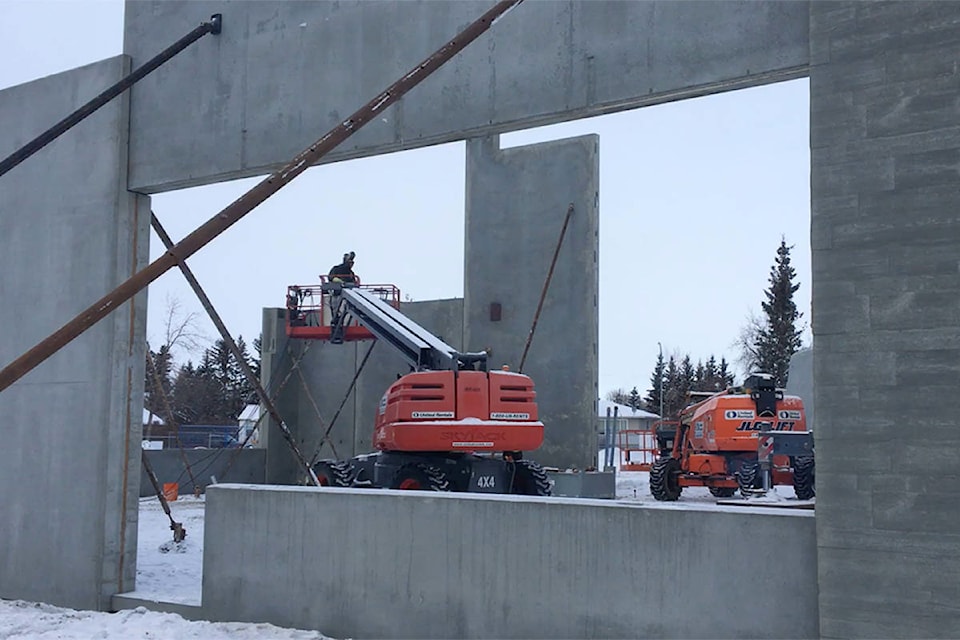With the Town of Ponoka’s new town hall under way, there are still some concerns around the terms of the agreement.
Council voted in favour of the lease agreement — which sees a public private partnership (P3) with developer Landrex — stating a focus on seeing new development in town. Where some took issue is the lease rates that would see the company receive about a 10 per cent return on investment.
That, compared to a two to three per cent interest rate with the Alberta Capital Finance Authority if the town constructed the building on its own, was part of the worry. Mayor Rick Bonnett, however, has been vocal about his support for the P3, stating other large capital projects such as a new RCMP building and a new field house will also have to be paid for.
The lease caused enough concern that resident Greg Nelson served the town notice, seeking to have councillors personally liable for the borrowing bylaw. It was determined that the building didn’t exceed the town’s borrowing due it being a lease with the town able to borrow $16 million and the building costing $9 million.
That’s where Ponoka County resident Nick Kohlman, and town resident Edwin Geuder voiced worry.
They have two major concerns. First, the long term cost of the lease to taxpayers should the town not exercise its buyout option; the second being that the length of the lease appears to show a much larger amount of money being spent.
“The cost of the learning centre lease according to the town’s auditor, with average inflation, is an estimated $22.8 million, plus a $2.4 million town cost for interior construction, for a total of about $25.2 million,” states a letter from Geuder and Kohlman.
They feel it’s an unresolved borrowing amount, it’s confusing for residents, and they would like to see the bylaw changed to clarify the lease amount against the cost of the building.
The value of the new town hall, at the time of the lease, was not indicated and was not included in the bylaw — which was something Justice Kevin Feehan in the court proceedings with the town was concerned about. Feehan even suggested the town amend its bylaw, which would create a public hearing process.
Council has not amended the bylaw, and that may not occur. This late into the construction of the new town hall, a successful petition against the amendments could cause a delay of construction and potentially legal issues.
“It is the borrowing bylaw that authorizes the expenditure for the lease. There is no indication in the bylaw to suggest that the borrowing is only $9 million,” states the letter.
Geuder and Kohlman argue that the lease exceeds the town’s borrowing, which makes councillors liable. That wasn’t the decision by Justice Feehan, however, he stated the law in the Municipal Government Act (MGA) regarding leases for capital projects in unclear.
Municipalities using PPPs
In an interview with Dr. Karim Jamal, department chairperson of University of Alberta’s accounting, operations and information systems, these P3s are usually done by municipalities looking to work with capital projects where they may not have enough to debenture.
“In this (Ponoka’s) case it appears more to be a foolish decision than anything else,” stated Jamal, who feels the town would have been better off doing the project on its own.
These types of long term leases are not new, and the MGA does not specifically address P3s. With international accounting standards, Jamal says leases such as these are not really part of determining debt. Municipalities and corporations have used this to some degree.
“It’s kind of a loophole effectively,” said Jamal.
“You kind of borrow in a way but it doesn’t get counted as a borrowing…you’re kind of relaxing the limit.”
The borrowing rate is unclear, something that Geuder and Kohlman point out in Ponoka’s case. Jamal calls it a legal manoeuvre.
“Once you sign the lease, effectively you’ve bought the building. You’re just not calling it a purchase, it’s just a lease,” explained Jamal.
Companies can move the debt within the same balance sheet because it’s a lease. But that’s changing.
“I think at the end of this year there’s a new lease standard change,” he explained.
One more project like the new town hall and Ponoka would have been over its borrowing limit, said Jamal, pointing out that the town is indeed within its borrowing limits.
When asked why the province allows P3s to occur, Jamal suggested planners may not have realized there was a loophole in accounting.
